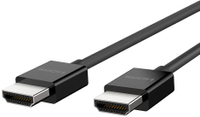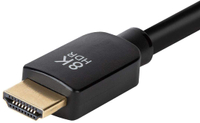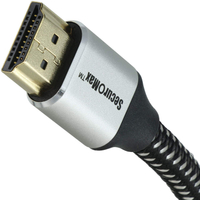That’s because HDMI 2.1 offers gamers the chance to make the most out of their latest gaming hardware, whether that’s the Xbox Series X or PS5, or one of the best graphics cards. With it, these consoles and cards hit upwards of 120 frames per second thanks to a TV’s native 120Hz refresh rate and and VRR. The bad news? Not all manufacturers are offering the connection as yet — so it’s something you’ll have to keep a keen eye out for. To that end, we’ve gathered a list of the best TVs with HDMI 2.1 support, along with handy advice about who needs HDMI 2.1, what features are offered as part of the 2.1 spec, and whether you need to buy new cables to really take advantage of those HDMI 2.1 connections. (Spoiler alert: You do.)
What are the best TVs with HDMI 2.1?
The best TV you can get with HDMI 2.1 is the new LG C2 OLED TV. This has four of the next-gen ports plus category-leading gaming performance to go with it. From the 120 Hz display to advanced support for Nvidia G-Sync and unique gaming features, it’s the best HDMI 2.1 TV we’ve seen. On the other hand, the LG G2 at number two looks a little more sleek and matches it for ports but is more expensive. For a non-OLED alternative, we love the Samsung QN90A Neo QLED TV, which includes one HDMI 2.1 port alongside several other best-in-class capabilities and the richest selection of smart features we’ve seen. But the big draw is the exquisite Neo QLED display, which is brighter and more vivid than OLED while offering near-OLED levels of crisp clarity and inky blacks. It was our favourite TV of 2021 but only having one HDMI 2.1 port takes it to second spot in this particular roundup. For a killer value, we recommend the Hisense U7G Android TV. It offers a pair of HDMI 2.1 ports, along with solid QLED performance and a handy two-position stand. But the real draw is gaming. Made to appeal to gamers, the HDMI 2.1 connectivity offers rich support for the expected features and the TV’s 17.2-millisecond lag time makes it very responsive.
The best HDMI 2.1 TVs you can buy
The LG C2 OLED TV is this year’s set to beat. Not only is it the best OLED TV thanks to an impressive display panel, but a premium design, maximum versatility and great smart TV platform hit all the high marks, too. What’s more, this C series lineup is LG’s largest in terms of size options — the configurations span from 42- to 83-inches, all of which sport full arrays of HDMI 2.1 ports. Most also feature LG’s evo OLED panel, which was first introduced on the LG G1 OLED TV and now looks to upgrade the C2’s performance. We can’t say our test results for this LG C2 OLED TV review showed significant improvement, but to be fair, there wasn’t much room to improve. Instead, what makes this one of the best TVs of the year is that it offers fantastic picture quality for the price — exactly what you’d expect from LG’s best-selling OLED TV series. Read our full LG C2 OLED review. LG really has nailed the whole HDMI 2.1 thing, and its new LG G2 OLED TV continues the fine tradition of including four of the next-gen ports in its thin frame. Nor are those HDMI 2.1 ports just an after-thought: the G2, like the C1 below and the forthcoming C2, has several other things to offer gamers. In our testing we measured a very low lag time of just 13.1 milliseconds, and while that’s slightly below the C1’s 12.6 milliseconds, it’s still a very good result. The dedicated gaming mode is also a bonus for anyone who owns a PS5 or Xbox Series X. Elsewhere, the LG G2 OLED improves upon last year’s G1 in almost every regard: it’s the brightest LG OLED ever, has impressive color accuracy and the deep blacks we’ve come to expect from the technology. It also sounds better than most OLED TVs, while LG’s WebOS is a decent smart TV platform, if not quite up there with the absolute best, due to a couple of missing apps. The LG C2, which we’re currently testing, may be a better purchase for most people, but until then this is the best HDMI 2.1 TV you can buy. Read our full LG G2 OLED TV review The Samsung QN90A Neo QLED TV combines Samsung’s highly refined quantum dot technology with the tight control of mini-LED backlighting, resulting in one of the best TV displays you’ll ever see. Brilliant color and unmatched brightness make for superb performance, and Samsung pairs that with a bounty of smart TV functions and genuinely intelligent features, like a solar-powered remote control that eliminates the need to swap out batteries — delivering eco-friendly design and unbeaten convenience at the same time. The whole thing is packed into a gorgeous 1-inch-thick design that contains a huge array of smart features, potent Dolby Atmos sound and some of the best performance we’ve ever seen. The only downside is that HDMI 2.1 connectivity is only in one HDMI port, but with gamer-friendly features and impressive 12.6-millisecond lag time it has plenty of other things to shout about. It’s the best TV we saw last year, for a start, and the winner of the 2021 Tom’s Guide Award for Best TV, as well as a second award as the best gaming TV of the year. Read our full Samsung QN90A Neo QLED TV review. The Hisense U8H Mini-LED TV is all about bringing high-end features to a mid-level price bracket. To wit, it’s packing a light sensor for Dolby Vision IQ that can raise or lower the brightness to match the ambient light in the room and a Mini-LED panel that has up to 528 local dimming zones. Its peak brightness exceeds any TV around that price, and its color reproduction is as good as some of this year’s best TVs. Not only does it have some smart-looking specs under its belt, it has some killer additional features — there’s two HDMI 2.1 ports that support 4K@120Hz and on-board Google TV 11 with Chromecast Built-in. Around back you’ll find a hefty sound system that delivers bass in spades, though it could be a bit stronger in the mid-range. Of course, there’s also an ATSC 3.0 tuner inside, too. The bad news? As powerful as a TV as this is, Hisense’s upscaling and motion processing skills aren’t on par with that of LG, Samsung or Sony’s, which means some scenes you’re going to notice poor motion smoothing and color banding. If those terms don’t mean much to you, these issues won’t ruin your experience — but videophiles might notice them and they can turn an otherwise positive experience into a sub-par one. Read our full Hisense U8H review. The Hisense U7G Android TV is being marketed as a TV built for gaming, and the specs make it easy to see why: The Quantum Dot display boasts good color and sharp images, the panel’s 120Hz refresh rate will handle the most demanding game console output, and a pair of HDMI 2.1 ports offer the best connectivity you can get for high-frame rate gaming. And any TV that’s good for gamers will usually do pretty well at everything else. Handling both Dolby Vision and HDR10 Plus formats, it’s got some of the best HDR support available, and Dolby Atmos sound means it has the audio to match. It impressed us in our testing, and it’s more affordable than you’d expect given the feature set. Gamer or not, the Hisense U7G Android TV is a solid 4K smart TV. Read our full Hisense U7G Android TV review. The Sony Bravia XR A80J is absolutely packed with flagship technologies: this 4K OLED TV has HDR, a 120 Hz refresh rate, ATSC 3.0 tuner, Google TV streaming and Sony’s own Bravia Core service, Acoustic Surface Audio+ technology… the list goes on. Sure, not everyone will need everything here, but it’s nice to have the option. Just as importantly, it also excels at the basics — contrast is superb, colors are rich and varied, viewing angles are impressive and it handles upscaling well. Sound is also excellent and Google TV is a big upgrade on the older Android TV. Against that, the XR A80J requires a little more tweaking in order to look its best; it’s fine out of the box, but to really reach its full potential, you’ll want to play around with various modes. It’s not the cheapest and other sets beat it purely based on picture quality, but as an all-round package the A80J is a great choice. Read our full Sony Bravia XR A80J review. In creating the Vizio M-Series Quantum X, Vizio was attempting to bring much of the same technology found in its popular — but expensive — Vizio P-Series Quantum X to a more affordable screen. By working in quantum dots with full array local dimming, a 120Hz native refresh rate and HDMI ports with the latest spec, the M-Series Quantum X checks all the boxes. That said, its bulky body and less-than-ideal peak brightness hold it back from beating other top-performing TVs at this price range. But where does it stand against the competition? Similarly priced screens will be missing many of the M-Series Quantum X’s key gaming features: a native 120Hz refresh rate with HDMI 2.1 ports and support for Dolby Vision Gaming. On the flip side, though, other screens on our list do have a bit better HDR performance and less bulky design, so there are trade-offs to be made here. If you’re not picky about having a full array of HDMI 2.1 ports to pick from, it’s a solid option for shoppers who want to save a buck. Read our full Vizio M-Series Quantum X review. Vizio’s most affordable 4K smart TV offers a better bang for the buck than ever before, with a trio of HDMI 2.1 ports, support for advanced features like variable refresh rates (VRR) and voice control, along with Dolby Vision and HDR10 Plus – two HDR formats you rarely see supported on the same TV at this price. It’s not a perfect TV, and there are some compromises made to achieve the low price, namely an unsophisticated backlight for poor brightness and HDR performance and middling (though surprisingly loud) audio. But with the best version of Vizio’s SmartCast software and a small selection of popular apps, it may still be one of the best TVs for the price, with even the largest model selling for under $1,000 and most screen sizes selling for under $500. Read our full Vizio V-Series (2021 Model) review. When it comes to 8K TVs, there are plenty of ultra-premium sets you can choose from, but TCL has stepped things up by bringing the price down. The TCL 6-Series 8K Roku TV (R648) is the most affordable 8K TV on the market, and it’s even more affordable than some of the 4K sets we recommend. Plus, it’s got the excellent Roku interfacer and short lag times for gaming. By offering next-gen resolution at current-gen prices, it’s the 8K TV we recommend — or, that we would recommend, if we thought people should be buying 8K TVs (which we don’t). Our only issues with the TV’s performance were the 8K panel’s limited viewing angles and the mediocrity of the audio, which can be solved with one of the best soundbars. But the bigger issue is one facing any 8K TV out there: There’s next to nothing you can watch in 8K, and that may not change anytime soon. Read our full TCL 6-Series 8K Roku TV (R648) review.
What is HDMI 2.1?
HDMI has been around for several years, but while the HDMI ports on your 4 or 5-year-old TV may look the same as the ports on the top models listed here, not all HDMI connections offer the same functionality. The latest HDMI standard is HDMI 2.1, which features increased bandwidth (48 Gbps) to move a lot more data. With nearly three times the bandwidth of HDMI 2.0 (18 Gbps, or enough for 4K video at 60 frames per second). HDMI 2.1 supports uncompressed 8K video at up to 60 Hz, or 4K video at up to 120 Hz. It’s essentially a much larger pipe for information back and forth from video sources such as 4K Blu-ray players and game consoles and out to other devices, such as soundbars. That increased data allows for higher resolutions and higher frame rates, making it essential for 8k TVs and high frame rate 4K gaming. Other key features include: Auto low latency mode (ALLM) detects when a game console is connected or powered on, and allows the TV to automatically switch to game mode, turning off unnecessary video processing to reduce lag times. It’s one less step you’ll need to take before getting into your game. Variable refresh rate (VRR) uses adaptive sync technology similar to Nvidia G-Sync and AMD FreeSync, aligning the TVs refresh rate with the frame rate of a connected game console. By matching refresh rate to frame rate, the TV is able to play games with perfect smoothness, eliminating any judder or screen tearing that can be caused by new frames rendering mid refresh. Enhanced audio return channel (eARC) is another great feature offered on HDMI 2.1 (but not exclusively, it can also be found on the more common HDMI 2.0 connection) which allows you to use a single HDMI cable to connect a TV to a soundbar or other audio equipment, without requiring additional cables. ARC allows a downstream connection over HDMI, meaning that you can use one of your regular HDMI connections to output audio to a soundbar. With the higher bandwidth and HDMI 2.1, ARC technology is updated and enhanced to support uncompressed audio formats, such as Dolby Atmos. (Read our article What is HDMI ARC? to learn more.)
Who needs HDMI 2.1?
There are a few instances where HDMI 2.1 will be indispensable, with features that require the new high bandwidth connection. The first is gaming. If you want to get the best possible performance from a new PS5 or Xbox Series X, you’ll need to take advantage of the console’s HDMI 2.1 connectivity, and that means using a TV that has HDMI 2.1, and using a compatible HDMI cable. Features above like ALLM and VRR are only available in the 2.1 spec, so we firmly recommend HDMI 2.1 for anyone looking for the best gaming TVs. Secondly if you’ve forked out for a Dolby Atmos soundbar (after reading our best soundbars in 2022 article, of course), HDMI 2.1 ports will offer you eARC as standard, meaning your soundbar can receive an uncompressed Dolby Atmos soundtrack from your TV, for the best possible audio performance.
What about 8K TVs with HDMI 2.1?
8K early adopters will need HDMI 2.1. As the first single HDMI connection capable of carrying 8K resolution at watchable frame rates, HDMI 2.1 is indispensable for 8K. Or it will be, whenever 8k media really arrives. For the time being, there is nothing noteworthy, which is why we don’t recommend 8K TVs at this time. There are no 8K-enabled media players or game consoles either, so it’s kind of a moot point. Sure, the Xbox Series X and PS5 can handle 8K in theory, but it’s not enabled yet. And even if it were, there’s a big doubt about whether we will see 8K native gaming any time soon. When 8K media does arrive – and it’s not a matter of “if” but “when” – HDMI 2.1 is the current standard it will use, so early adopters will want to keep an eye out for the new spec now.
What about HDMI 2.1 cables?
I know what you’re asking yourself right now, and the answer is “Yes.” Yes, the new HDMI standard will require new cables. Because the new HDMI 2.1 specification offers significantly more bandwidth and features than older versions, using an older HDMI cable just won’t cut it. That’s not to say that an older cable won’t work. The different versions of HDMI are backwards compatible, so you can still connect with an older cable, but you will give up the bandwidth and features that the 2.1 spec offers, and the older cable will serve as a bottleneck, preventing the higher resolution and frame rates you would otherwise be able to enjoy. Here are some HDMI 2.1 cables we recommend.
How we test TVs with HDMI 2.1
Like every other TV we review, all of the above TVs were put through our rigorous testing process. Our collection of lab tests measure color gamut, color accuracy and brightness to objectively see which sets are the best for these key indicators. We use these results to make numbers-based comparisons about color and display quality. We also test for lag time, measuring to the millisecond how long it takes for content to travel from the original video source to the screen. TVs with shorter lag time offer better gaming performance, an especially important concern for HDMI 2.1 shoppers, who are most likely to be using the new connection to get the most from their game console. We spend hours with each set to see how our lab results translate into anecdotal performance. We also compare competing sets using a range of content across several sources. With that information, we can tell you which TVs look best, sound best and offer the best viewing experience. Of course, we also consider the smart TV functions and apps for each TV, looking at everything from the remote control design to the voice interaction.


















